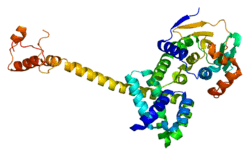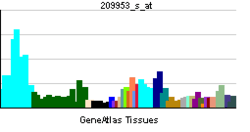CDC37
| Cdc37 N terminal kinase binding | |||||||||
|---|---|---|---|---|---|---|---|---|---|
| Identifiers | |||||||||
| Symbol | CDC37_N | ||||||||
| Pfam | PF03234 | ||||||||
| InterPro | IPR013855 | ||||||||
| SCOP | 1us7 | ||||||||
| SUPERFAMILY | 1us7 | ||||||||
| |||||||||
| Cdc37 Hsp90 binding domain | |||||||||
|---|---|---|---|---|---|---|---|---|---|
 complex of hsp90 and p50 | |||||||||
| Identifiers | |||||||||
| Symbol | CDC37_M | ||||||||
| Pfam | PF08565 | ||||||||
| InterPro | IPR013874 | ||||||||
| SCOP | 1us7 | ||||||||
| SUPERFAMILY | 1us7 | ||||||||
| |||||||||
| Cdc37 C terminal domain | |||||||||
|---|---|---|---|---|---|---|---|---|---|
 complex of hsp90 and p50 | |||||||||
| Identifiers | |||||||||
| Symbol | CDC37_C | ||||||||
| Pfam | PF08564 | ||||||||
| InterPro | IPR013873 | ||||||||
| SCOP | 1us7 | ||||||||
| SUPERFAMILY | 1us7 | ||||||||
| |||||||||
Hsp90 co-chaperone Cdc37 is a protein that in humans is encoded by the CDC37 gene.[1][2]
The protein encoded by this gene is highly similar to Cdc 37, a cell division cycle control protein of Saccharomyces cerevisiae. This protein is a molecular chaperone with specific function in cell signal transduction. It has been shown to form complex with Hsp90 and a variety of protein kinases including CDK4, CDK6, SRC, RAF1, MOK, as well as eIF-2 alpha kinases. It is thought to play a critical role in directing Hsp90 to its target kinases.[3]
Interactions
CDC37 has been shown to interact with:
Domain architecture
CDC37 consists of three structural domains. The N-terminal domain binds to protein kinases.[11] The central domain is the Hsp90 chaperone (heat shock protein 90) binding domain.[12] The function of the C-terminal domain is unclear.
References
- ↑ 1.0 1.1 Dai K, Kobayashi R, Beach D (Oct 1996). "Physical interaction of mammalian CDC37 with CDK4". J Biol Chem 271 (36): 22030–4. doi:10.1074/jbc.271.36.22030. PMID 8703009.
- ↑ 2.0 2.1 Stepanova L, Leng X, Parker SB, Harper JW (Aug 1996). "Mammalian p50Cdc37 is a protein kinase-targeting subunit of Hsp90 that binds and stabilizes Cdk4". Genes Dev 10 (12): 1491–502. doi:10.1101/gad.10.12.1491. PMID 8666233.
- ↑ "Entrez Gene: CDC37 cell division cycle 37 homolog (S. cerevisiae)".
- ↑ Ewing RM, Chu P, Elisma F, Li H, Taylor P, Climie S, McBroom-Cerajewski L, Robinson MD, O'Connor L, Li M, Taylor R, Dharsee M, Ho Y, Heilbut A, Moore L, Zhang S, Ornatsky O, Bukhman YV, Ethier M, Sheng Y, Vasilescu J, Abu-Farha M, Lambert JP, Duewel HS, Stewart II, Kuehl B, Hogue K, Colwill K, Gladwish K, Muskat B, Kinach R, Adams SL, Moran MF, Morin GB, Topaloglou T, Figeys D (2007). "Large-scale mapping of human protein-protein interactions by mass spectrometry". Mol. Syst. Biol. 3 (1): 89. doi:10.1038/msb4100134. PMC 1847948. PMID 17353931.
- ↑ Lamphere L, Fiore F, Xu X, Brizuela L, Keezer S, Sardet C, Draetta GF, Gyuris J (1997). "Interaction between Cdc37 and Cdk4 in human cells". Oncogene 14 (16): 1999–2004. doi:10.1038/sj.onc.1201036. PMID 9150368.
- ↑ Roe SM, Ali MM, Meyer P, Vaughan CK, Panaretou B, Piper PW, Prodromou C, Pearl LH (2004). "The Mechanism of Hsp90 regulation by the protein kinase-specific cochaperone p50(cdc37)". Cell 116 (1): 87–98. doi:10.1016/S0092-8674(03)01027-4. PMID 14718169.
- ↑ Silverstein AM, Grammatikakis N, Cochran BH, Chinkers M, Pratt WB (1998). "p50(cdc37) binds directly to the catalytic domain of Raf as well as to a site on hsp90 that is topologically adjacent to the tetratricopeptide repeat binding site". J. Biol. Chem. 273 (32): 20090–5. doi:10.1074/jbc.273.32.20090. PMID 9685350.
- ↑ Bouwmeester T, Bauch A, Ruffner H, Angrand PO, Bergamini G, Croughton K, Cruciat C, Eberhard D, Gagneur J, Ghidelli S, Hopf C, Huhse B, Mangano R, Michon AM, Schirle M, Schlegl J, Schwab M, Stein MA, Bauer A, Casari G, Drewes G, Gavin AC, Jackson DB, Joberty G, Neubauer G, Rick J, Kuster B, Superti-Furga G (2004). "A physical and functional map of the human TNF-alpha/NF-kappa B signal transduction pathway". Nat. Cell Biol. 6 (2): 97–105. doi:10.1038/ncb1086. PMID 14743216.
- ↑ 9.0 9.1 Chen G, Cao P, Goeddel DV (2002). "TNF-induced recruitment and activation of the IKK complex require Cdc37 and Hsp90". Mol. Cell 9 (2): 401–10. doi:10.1016/S1097-2765(02)00450-1. PMID 11864612.
- ↑ Boudeau J, Deak M, Lawlor MA, Morrice NA, Alessi DR (2003). "Heat-shock protein 90 and Cdc37 interact with LKB1 and regulate its stability". Biochem. J. 370 (Pt 3): 849–57. doi:10.1042/BJ20021813. PMC 1223241. PMID 12489981.
- ↑ Kimura Y, Rutherford SL, Miyata Y, Yahara I, Freeman BC, Yue L, Morimoto RI, Lindquist S (July 1997). "Cdc37 is a molecular chaperone with specific functions in signal transduction". Genes Dev. 11 (14): 1775–85. doi:10.1101/gad.11.14.1775. PMID 9242486.
- ↑ Turnbull EL, Martin IV, Fantes PA (August 2005). "Cdc37 maintains cellular viability in Schizosaccharomyces pombe independently of interactions with heat-shock protein 90". FEBS J. 272 (16): 4129–40. doi:10.1111/j.1742-4658.2005.04825.x. PMID 16098195.
Further reading
- Dey B, Lightbody JJ, Boschelli F (1997). "CDC37 is required for p60v-src activity in yeast.". Mol. Biol. Cell 7 (9): 1405–17. doi:10.1091/mbc.7.9.1405. PMC 275990. PMID 8885235.
- Lamphere L, Fiore F, Xu X et al. (1997). "Interaction between Cdc37 and Cdk4 in human cells.". Oncogene 14 (16): 1999–2004. doi:10.1038/sj.onc.1201036. PMID 9150368.
- Kimura Y, Rutherford SL, Miyata Y et al. (1997). "Cdc37 is a molecular chaperone with specific functions in signal transduction.". Genes Dev. 11 (14): 1775–85. doi:10.1101/gad.11.14.1775. PMID 9242486.
- Silverstein AM, Grammatikakis N, Cochran BH et al. (1998). "p50(cdc37) binds directly to the catalytic domain of Raf as well as to a site on hsp90 that is topologically adjacent to the tetratricopeptide repeat binding site.". J. Biol. Chem. 273 (32): 20090–5. doi:10.1074/jbc.273.32.20090. PMID 9685350.
- Grammatikakis N, Lin JH, Grammatikakis A et al. (1999). "p50(cdc37) acting in concert with Hsp90 is required for Raf-1 function.". Mol. Cell. Biol. 19 (3): 1661–72. PMC 83960. PMID 10022854.
- O'Keeffe B, Fong Y, Chen D et al. (2000). "Requirement for a kinase-specific chaperone pathway in the production of a Cdk9/cyclin T1 heterodimer responsible for P-TEFb-mediated tat stimulation of HIV-1 transcription.". J. Biol. Chem. 275 (1): 279–87. doi:10.1074/jbc.275.1.279. PMID 10617616.
- Hartson SD, Irwin AD, Shao J et al. (2000). "p50(cdc37) is a nonexclusive Hsp90 cohort which participates intimately in Hsp90-mediated folding of immature kinase molecules.". Biochemistry 39 (25): 7631–44. doi:10.1021/bi000315r. PMID 10858314.
- Shao J, Grammatikakis N, Scroggins BT et al. (2001). "Hsp90 regulates p50(cdc37) function during the biogenesis of the activeconformation of the heme-regulated eIF2 alpha kinase.". J. Biol. Chem. 276 (1): 206–14. doi:10.1074/jbc.M007583200. PMID 11036079.
- Hartley JL, Temple GF, Brasch MA (2001). "DNA cloning using in vitro site-specific recombination.". Genome Res. 10 (11): 1788–95. doi:10.1101/gr.143000. PMC 310948. PMID 11076863.
- Rao J, Lee P, Benzeno S et al. (2001). "Functional interaction of human Cdc37 with the androgen receptor but not with the glucocorticoid receptor.". J. Biol. Chem. 276 (8): 5814–20. doi:10.1074/jbc.M007385200. PMID 11085988.
- Simpson JC, Wellenreuther R, Poustka A et al. (2001). "Systematic subcellular localization of novel proteins identified by large-scale cDNA sequencing.". EMBO Rep. 1 (3): 287–92. doi:10.1093/embo-reports/kvd058. PMC 1083732. PMID 11256614.
- Scholz GM, Cartledge K, Hall NE (2001). "Identification and characterization of Harc, a novel Hsp90-associating relative of Cdc37.". J. Biol. Chem. 276 (33): 30971–9. doi:10.1074/jbc.M103889200. PMID 11413142.
- Chen G, Cao P, Goeddel DV (2002). "TNF-induced recruitment and activation of the IKK complex require Cdc37 and Hsp90.". Mol. Cell 9 (2): 401–10. doi:10.1016/S1097-2765(02)00450-1. PMID 11864612.
- Siligardi G, Panaretou B, Meyer P et al. (2002). "Regulation of Hsp90 ATPase activity by the co-chaperone Cdc37p/p50cdc37.". J. Biol. Chem. 277 (23): 20151–9. doi:10.1074/jbc.M201287200. PMID 11916974.
- Basso AD, Solit DB, Chiosis G et al. (2002). "Akt forms an intracellular complex with heat shock protein 90 (Hsp90) and Cdc37 and is destabilized by inhibitors of Hsp90 function.". J. Biol. Chem. 277 (42): 39858–66. doi:10.1074/jbc.M206322200. PMID 12176997.
- Abbas-Terki T, Briand PA, Donzé O, Picard D (2003). "The Hsp90 co-chaperones Cdc37 and Sti1 interact physically and genetically.". Biol. Chem. 383 (9): 1335–42. doi:10.1515/BC.2002.152. PMID 12437126.
- Strausberg RL, Feingold EA, Grouse LH et al. (2003). "Generation and initial analysis of more than 15,000 full-length human and mouse cDNA sequences.". Proc. Natl. Acad. Sci. U.S.A. 99 (26): 16899–903. doi:10.1073/pnas.242603899. PMC 139241. PMID 12477932.
- Boudeau J, Deak M, Lawlor MA et al. (2003). "Heat-shock protein 90 and Cdc37 interact with LKB1 and regulate its stability.". Biochem. J. 370 (Pt 3): 849–57. doi:10.1042/BJ20021813. PMC 1223241. PMID 12489981.
| |||||||||
This article incorporates text from the public domain Pfam and InterPro IPR013855
This article incorporates text from the public domain Pfam and InterPro IPR013874
This article incorporates text from the public domain Pfam and InterPro IPR013873

